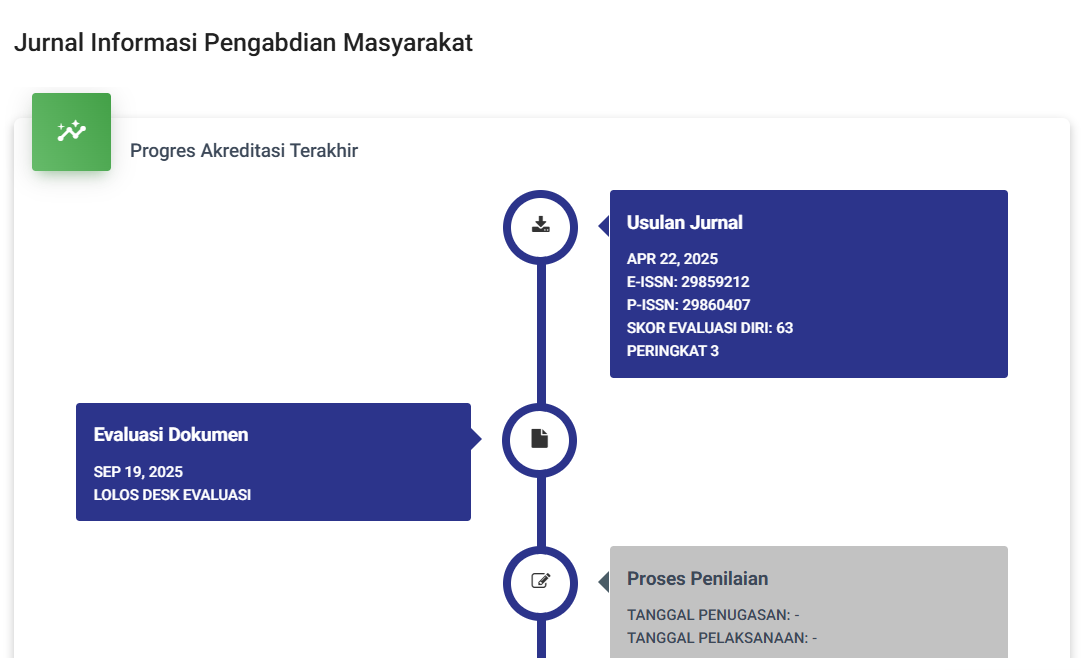Penyuluhan dan Pemberdayaan Kader Tentang Penyakit Kecacingan di Desa Bone Kecamatan Nekamese Kabupaten Kupang
DOI:
https://doi.org/10.47861/jipm-nalanda.v1i4.526Keywords:
Worm Disease, Children Cadre, Healthy Life BehaviourAbstract
Worms are a health problem that is still widely found. Worms caused by several intestinal worms transmitted through the soil are called Soil Transmitted Helminths (STH). Elementary school children are an age group that is susceptible to infection with worms. Worm infections can have a serious impact if not treated with deworming medication and a clean and healthy lifestyle of the person. This community service is carried out to be an outreach to improve and empower the community, especially elementary schools, about clean living behavior in dealing with worms. Behaviors such as hand washing habits, nail hygiene, footwear habits, bowel habits and to determine environmental sanitation risk factors such as latrine ownership, availability of clean water, and ownership of trash bins related to stunting in children’s parents Bone Village, Nekamese District. The number of children is 28 people. Counseling and empowerment of cadres about worms in Bone Village, Nekamese District, Kupang Regency has been carried out well involving the children's parents. The evaluation showed a good increase in understanding about worms from cadres, children and parents.
References
Alfitra, A. (2017). Peran Orang Tua Dengan Kepatuhan Mencuci Tangan Menggunakan Sabun Pada Anak Usia Sekolah (Studi Kasus Di Sekolah Dasar Negeri 4 Kumpai Batu Bawah, Kec. Arut Selatan, Kab. Kotawaringin Barat, Pangkalan Bun-Kalimantan Tengah). STIKES Insan Cendekia Medika Jombang.
Andaruni, A. (2012). Gambaran faktor-faktor penyebab infeksi cacingan pada anak di SDN 01 pasirlangu cisarua. Students E-Journal, 1(1), 28.
Bria, M., Arwati, H., & Tantular, I. S. (2021). Prevalence and risk factors of Ascaris lumbricoides infection in children of Manusak Village, Kupang District, East Nusa Tenggara Province, Indonesia. Qanun Medika-Medical Journal Faculty of Medicine Muhammadiyah Surabaya, 5(2).
Departemen Kesehatan RI. (2015). Sistem Kesehatan Nasional. Http:// Www.Depkes.Go.Id.
Kemenkes RI. (2015). Rencana Strategis Kementerian Kesehatan Tahun 2015-2019. Http://Ppid.Kemenkes.Co.Id. http://ppid.kemkes.go.id/uploads/img_5cd07f7e6d039.pdf
Koro, A. . (2018). Prevalensi Enterobiasis pada anak usia 2-9 tahun di dusun 1 desa Oelomin Kecamatan Nekamese Kabupaten Kupang Tahun 2018. Politeknik Kesehatan Kemenkes, Kupang.
Rawina, W., & Mulyati, A. H. (2012). Upaya pemberantasan kecacingan di sekolah dasar. Makara Kesehatan, 16(2), 65–71.
Retno A, A. R., & Artanti, D. (2019). Modul Pratikum Parasitologi 2.
Sardjono, T. W., Baskoro, A. D., Endharti, A. T., Fitri, L. E., Poeranto, S., & Nugraha, R. Y. B. (2020). Helmintologi Kedokteran dan Veteriner: Edisi Revisi. Universitas Brawijaya Press.
Sha-Mohammadi, Z., Ghahramani, F., Mahboubi, M., Jalilian, F., Neiakane-Shahri, M., & Mohammadi, M. (2014). Prevalence of Enterobius Vermicularis (pinworm) in Kermanshah city nurseries, using Graham: 2014. J Biol Today’s World, 3(1), 24–27.
Silitonga, M. M., Sudharmono, U., & Hutasoit, M. (2009). Prevalensi kecacingan pada murid sekolah dasar negeri di desa Cihanjuang Rahayu Parongpong Bandung Barat. Majalah Kedokteran Bandung, 41(2).
Suriani, E., Irawati, N., & Lestari, Y. (2020). Analisis Faktor Penyebab Kejadian Kecacingan pada Anak Sekolah Dasar di Wilayah Kerja Puskesmas Lubuk Buaya Padang Tahun 2017. Jurnal Kesehatan Andalas, 8(4).
World Health Organization. (2016). Soil Transmitted Helminths Infection. Www.Who.Int/Intestinal_worms.
Yudhastuti, R. (2012). Kebersihan diri dan sanitasi rumah pada anak balita dengan kecacingan. Jurnal Kesehatan Masyarakat Nasional, 6(4), 173–178.
Downloads
Published
How to Cite
Issue
Section
License
Copyright (c) 2023 Meliance Bria, Murry Jermias Kale, Ni Made Susilawati

This work is licensed under a Creative Commons Attribution-ShareAlike 4.0 International License.










